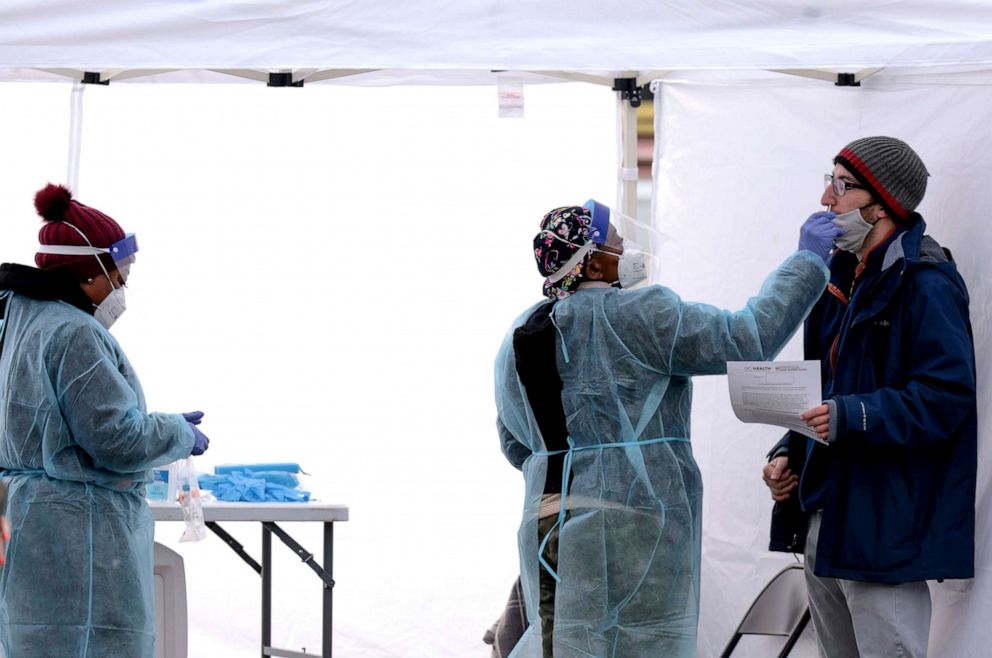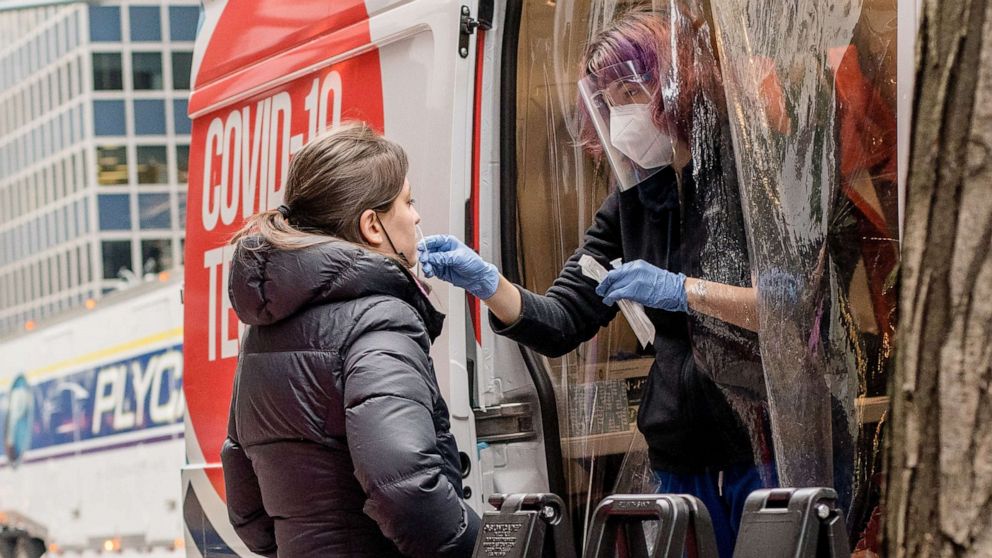在整个疫情,对新冠肺炎(新型冠状病毒肺炎)测试——通常是在病例激增期间或假期旅行之前——给国家的测试能力带来了压力。
在这段时间里,人们很难快速了解自己是否对病毒呈阳性,如果呈阳性,也很难进行隔离。
从严格的规则和初始测试套件的问题,到如何在高峰期和间歇期管理供应和需求,测试是美国一直在努力争取的事情。2021年,美国正在努力应对如何管理一个全面重新开放的国家所需的检测量,该国的学校和工作场所需要定期检测,在假期前传染性极强的omicron变体来袭期间,压力加剧了。
这提出了一个真正的问题,因为专家们认为,一个成功的新冠肺炎检测制度——以及疫苗接种——是建立新常态的关键。
在疫情的过程中,测试的数量和类型激增,结果的周转时间各不相同,并且出现了其他问题,包括应该使用哪种测试以及应该在何时何地进行测试。
那么,如果COVID将成为一种地方病,这意味着它总是在人群中传播,但传播速度很低,那么美国如何增加检测机会,需要什么样的基础设施。需要什么样的测试系统来防止由包括delta和希腊字母第15字?
检测专家告诉美国广播公司新闻,答案是分散系统,直接向患者提供检测,建立社区网站,进行可靠的快速分子检测,并能够同时检测人的多种疾病,包括COVID。

安娜·赚钱者/盖蒂图像公司
医护人员在法拉格特广场的一个免费测试点进行新冠肺炎聚合酶链反应测试.
我们现在的测试
目前,美国有两种不同类型的病毒检测用于诊断新冠肺炎:抗原检测和分子检测。
抗原检测,也称为快速检测,从冠状病毒中寻找抗原或蛋白质,通常在不到一小时内返回结果。分子测试,也称为聚合酶链反应测试,在实验室中对病毒材料进行,通常在三天内返回结果。
聚合酶链反应检测大多在政府运营的场所、急救中心、医生办公室和药店进行,其中许多在奥米克龙变种引发的激增中排起了长队。最近几周,家庭抗原检测作为一种避免排队和快速确定一个人是否被感染的方法,越来越受欢迎。
专家们说,omicron变体继续传播的速度将决定美国目前是否有足够的测试能力。
“当然,我们有很多测试,我认为,目前,在这个国家,当你考虑到所有可用的东西时,我们可以在一天内提供超过200万或300万次(实验室)测试,”梅奥诊所实验室医学系主任威廉·莫瑞斯博士告诉美国广播公司新闻。
根据疾病控制和预防中心的数据,目前美国平均每天进行170万次新冠肺炎检测。然而,专家说我们应该进行更多的测试。
加州大学旧金山分校的传染病专家彼得·钦洪博士告诉美国广播公司新闻,美国需要进行更多的测试——每天超过200万或300万次——这样感染者就可以更快地得到他们需要的治疗,避免被送往医院,并可以进行接触者追踪。
“使用检测,并不像显示我们有多少病例那么多,但它实际上是用于诊断的,”Chin-Hong说。“当人们在早期使用检测时,他们可以通过早期治疗获得更好的回报,并防止他们去医院。
他继续说,“聚合酶链反应检测可以触发接触追踪,早期治疗。测试还有很多其他多米诺骨牌效应,不仅仅是“我的社区里还有一个案例”它实际上最终可能会节省医院资源。"
莫赖斯认为,如果病例继续上升,那么供应可能会紧张。截至1月7日,美国平均每天记录超过66.8万例感染——这是自疫情疫情开始以来的最高水平,尽管这一数字部分是由于假期期间数据报告的积压。
“当病毒不流行并且在社区中不太常见时,我们已经进行的检测,例如在西雅图,已经相当充分了,”UW医学实验室医学和病理学系主任杰弗里·贝尔德博士告诉美国广播公司新闻。“我认为,如果我们只是对有症状的人进行测试,我们有很多测试可以利用。”
他继续说道,“但当你必须在旅行前、聚会前、上学前或运动前对无症状的人进行检测时,这最终会变得难以支持,因为所需检测的绝对数量可能会非常非常大。”

肖恩·戈德堡/SOPA图片通过ZUMA电线
一名卫生工作者从一个人身上采集拭子样本,用于在流动诊所进行新冠肺炎检测...
专家表示,传染病建模人员没有预测到omicron变体的出现或其传播速度,尤其是当人们在假期旅行时,导致测试需求增加。
克利夫兰诊所病理学和检验医学研究所教授兼主席布莱恩·鲁宾博士告诉美国广播公司新闻,在他的实验室,2021年的阳性检测比前一年增加了约50%。
在前一次冬季激增期间,该诊所每天的阳性检测从未超过1000次。他说,2021年末,每天有多达1700项检测结果呈阳性。每天要进行多达4000到5000次测试,这给医院、实验室人员和测试用品带来了巨大压力。
我们需要的系统
鲁宾认为,建立强大测试计划的关键是进一步分散美国的系统,这意味着更多的家庭测试,而不需要医疗保健提供商订购或执行测试。
“我们能做的任何事情都可以实现自动化,”他说。“权力下放将是关键。我们怎么能不打电话给他们的医生,让他们自己做检查等等。”
他补充说,“如果我们能让真正可靠的测试落到个人手中,这样你就可以在家测试,而不用离开你的家,我们可以处理它。”
尽管目前上架的大多数在家测试都非常可靠,但一些在家测试会产生大量的假阳性。
他设想了一个系统,在这个系统中,美国使用亚马逊或类似亚马逊的服务,以比现有规模更大的规模向人们的家庭提供测试包。
人们自己进行测试,包括擦拭和分析样品。一旦他们得到结果,他们会扫描条形码或二维码,提醒公共卫生官员检测结果呈阳性,而不是该人必须打电话给医生或当地卫生部门通知他们。虽然有些测试已经做到了这一点,但是Rubin希望看到所有的测试都具有这种能力。
如果一个人有症状,在家测试产生假阳性的可能性非常低。因此,根据鲁宾提出的系统,如果这个人有症状并且得到了积极的结果,他们可以呆在家里,因此有助于消除测试场所的排长队,并节省诊所的预约时间。
然而,如果一个人没有症状,并且在家庭测试中获得阳性结果,建议他进行聚合酶链反应测试,以确认他们确实感染了COVID。
此外,在鲁宾的系统下,如果某人是阳性患者的接触者,他们将被告知并获得关于是接受检测还是隔离的指导。
他说:“我们有所有用于家庭测试的零件,但我们如何让它超级优雅和光滑,并使它尽可能简单。
拜登政府正试图通过类似的方法增加测试:创建一个网站,向美国人分发5亿份免费的家庭快速COVID测试,官员们承诺不会削减目前上架的测试供应。
可能的挫折
然而,快速测试也有问题。在家测试涉及多个步骤,需要干净的工作空间,这意味着人们可能会错误地执行测试。此外,快速测试比实验室测试更有可能返回假阴性,因为它们不太敏感。
这意味着快速检测必须在鼻子中检测到足够的抗原或蛋白质,才能返回阳性结果。然而,寻找遗传物质的实验室测试可以返回阳性结果,即使只检测到微量。
由于这些潜在的问题,贝尔德说,他赞成建立社区检测站,就像UW医学在华盛顿所做的那样,使用快速分子检测。
这些就像PCR检测,被认为是检测的黄金标准,但在几个小时内而不是几天内返回结果。
UW社区网站收集样本,然后通过快递运回主实验室,在那里可以快速分析,贝尔德希望看到全国各地的大医院建立类似的系统。
“它给出假阴性的几率非常非常低。没有一个测试是100%完美的,但它是你能得到的最好的,所以我们正在尽我们所能,尽可能牺牲最好的测试,”贝尔德说。“我会支持多个社区测试站点,比如信息亭或拖车或其他站点,它可以在零售空间或类似的地方。”
莫瑞丝说,进行联合检测也很重要,这种检测可以检测多种疾病,比如新冠肺炎病和流感,虽然不是所有的诊所都有这种检测。
“这将非常重要,而且肯定是需要的,”他说。“去年真的很不寻常,因为我们没有任何流感。现在我们看到利率回升,因此我们需要它。”
COVID may be with us for a long time. What kind of testing do we need?
Throughout the pandemic, periodic surges in demand forCOVID-19testing -- typically during a spike in cases or prior to holiday travel -- have put strain on the nation's testing capacity.
During these times, it can be difficult for people to quickly learn if they are positive for the virus -- and to isolate if they are.
Testing is something the U.S. has struggled to get right from the get-go, from strict rules and problems with the initial test kits to how to manage supply and demand during peaks and lulls. In 2021, America grappled with how to manage the volume of tests needed in a fully reopened country with schools and workplaces requiring regular testing, pressures exacerbated during the highly contagious omicron variant hitting ahead of the holidays.
This presents a real problem because experts believe a successful COVID-19 testing regime -- along with vaccinations -- is the key to building a new normal.
Over the course of the pandemic, the number and types of tests have proliferated, turnaround times for results have varied and other questions arose, including which test should be used and when and where should they be administrated.
So how can the U.S. increase access to tests, and what kind of infrastructure is needed if COVID is going to be an endemic disease, meaning it is always circulating within the population but at low rates. What kind of testing system is needed to prevent further outbreaks fueled by variants including delta andomicron?
Testing experts told ABC News the answer is decentralizing the system and delivering tests to patients directly, setting up community sites with reliable rapid molecular testing and being able to test people for multiple diseases at one time -- including COVID.
The tests we have now
Currently, the U.S. has two different types of viral tests used to diagnose COVID-19: antigen tests and molecular tests.
Antigen tests, also known as rapid tests, look for antigens, or proteins, from the coronavirus and return results usually within less than an hour. Molecular tests, also known as PCR tests, are run in a laboratory for viral material and typically return results within three days.
PCR tests are mostly administered at government-run sites, urgent care centers, doctor's offices and pharmacies, many of which have seen long lines amid the surge fueled by the omicron variant. At-home antigen tests have soared in popularity in recent weeks as way to avoid lines and quickly determine whether or not a person is infected.
How quickly the omicron variant continues to spread will determine whether the U.S. has enough testing capacity for now, the experts say.
"Certainly we have a lot of testing and I think, currently, in the country we can provide well north of two or three million [lab] tests in a day when you consider everything that's available," Dr. William Morice, chair of the Department of Laboratory Medicine at Mayo Clinic, told ABC News.
Currently, the U.S. is performing an average of 1.7 million COVID-19 tests per day, according to data from the Centers for Disease Control and Prevention (CDC). However, experts say we should be performing more tests than that.
Dr. Peter Chin-Hong, an infectious diseases specialist at the University of California, San Francisco, told ABC News that the U.S. needs to be performing many more tests -- upwards of 2 or 3 million per day -- so infected people can get the treatment they need more quickly, avoid being sent to the hospital and contact tracing can occur.
"Use of testing, it's not as much to show how many cases we have, but it's actually used for diagnosis " Chin-Hong said. "When people use testing early on, they can get better bang for their buck with early therapies and prevent them from going to the hospital.
He continued, "A PCR test can trigger contact tracing, early therapy. There are a lot of other domino effects of testing that's simply just more than 'I have another case in my community.' It actually ends up potentially saving hospital resources."
Morice believes that if cases continue to rise, then the supply could be strained. The U.S. is recording an average of more than 668,000 infections per day (as of Jan. 7) -- the most ever since the pandemic began, although this figure is partially due to a backlog of data reporting over the holidays.
"When the virus is not prevalent and less common in communities, the testing that we've had, for example here in Seattle, has been quite adequate," Dr. Geoffrey Baird, chair of the Department of Laboratory Medicine and Pathology at UW Medicine, told ABC News. "I think we have plenty of testing available if we were just testing people who have symptoms."
He continued, "But when you have to test asymptomatic people before traveling, before gatherings, before school or before sports, that ends up getting difficult to so support because the absolute number of tests needed can get very, very large."
The experts say that infectious disease modelers didn't predict the emergence of the omicron variant or how quickly it would spread -- especially as people traveled over the holidays -- leading to increased demand for testing.
Dr. Brian Rubin, professor and chairman of the Pathology and Laboratory Medicine Institute at the Cleveland Clinic, told ABC News that at his lab, there have been about 50% more positive tests in 2021 than the year before.
During the previous winter surge, the clinic never had more than 1,000 positive tests per day. In late 2021, as many as 1,700 tests per day come back positive, he said. With as many as 4,000 to 5,000 tests being run every day, this puts a great amount of strain on hospitals, laboratory personnel and testing supplies.
The system we need
Rubin believes the key to building up a robust testing program is to decentralize the system the U.S. has even further, meaning more at-home testing without the need of a healthcare provider to order or perform the test.
"Anything we can do to automate that," he said. "Decentralizing is going to be the key. How do we not call their doctor to order the test, get them to swab themselves, et cetera."
He added, "If we can get really reliable testing into the hands of individuals so you can test at home without leaving your home, we can handle it."
Although most at-home tests currently on shelves are pretty reliable, some at-home tests are known to produce an abundance of false positives.
He envisions a system in which the U.S. uses Amazon or an Amazon-like service to deliver test kits to people's homes on a grander scale than what is already available.
People perform the test themselves, including swabbing and analyzing the sample. Once they get results, they scan a barcode or QR code, alerting public health officials of a positive test result rather than the person having to call a doctor or the local health department to inform them. Although some tests already do this, Rubin would like to see all tests have this capability.
At-home tests have a very low likelihood of delivering false positives if a person is symptomatic. So, under Rubin's proposed system, if the person is symptomatic and gets a positive result, they could stay home and therefore help eliminate long lines at testing sites and free up appointments at clinics.
However, person who is asymptomatic and gets a positive result from a delivered at-home test would be recommended to get PCR test to confirm they are truly infected with COVID.
Additionally, under Rubin's system, if someone is a contact of a positive patient, they would be informed and get guidance on whether to get tested or quarantine.
"We have all the pieces for home testing, but how do we make it super elegant and slick and make it as easy as possible," he said.
The Biden administration is trying to ramp up testing via a similar method: creating a website that will distribute 500 million free at-home rapid COVID tests to Americans, which officials promised will not cut into the current supply of tests on shelves.
Possible setbacks
However there are issues with rapid tests. At-home testing involves multiple steps and requires a clean workspace, meaning people may be performing the tests incorrectly. Additionally, rapid tests are more likely to return false negatives than laboratory tests because they are less sensitive.
This means that rapid tests have to detect enough antigens, or proteins, in the nose to return a positive result. However, laboratory tests, which look for genetic material, can return a positive result even if only trace amounts are detected.
Because of these potential issues, Baird says he is in favor of setting up community testing sites like UW Medicine has done in Washington that use rapid molecular tests.
These are like PCR tests, which are considered the gold standard of testing, but return results within a few hours rather than within a few days.
The UW community sites collect samples, which are then shipped by courier back to the main lab, where they can be quickly analyzed, Baird would like to see a similar system set up by big hospitals across the country.
"The chances of it giving a false negative are very, very low. No test is 100% perfect but it's as good as you can get and so we're doing the best we can by making the best possible test as expendable as possible," Baird said. "I'd be in favor of multiple community test sites like kiosks or trailers or other sites, it can be in retail spaces or something like that."
Morice said it's also important to have combination tests that check for multiple diseases such as COVID-19 and the flu, which are currently available -- although not at all clinics.
"That will be really important and it's certainly needed," he said. "Last year was really anomalous in that we had no influenza whatsoever. Now we're seeing rates going back up so we'll need it for that reason."






